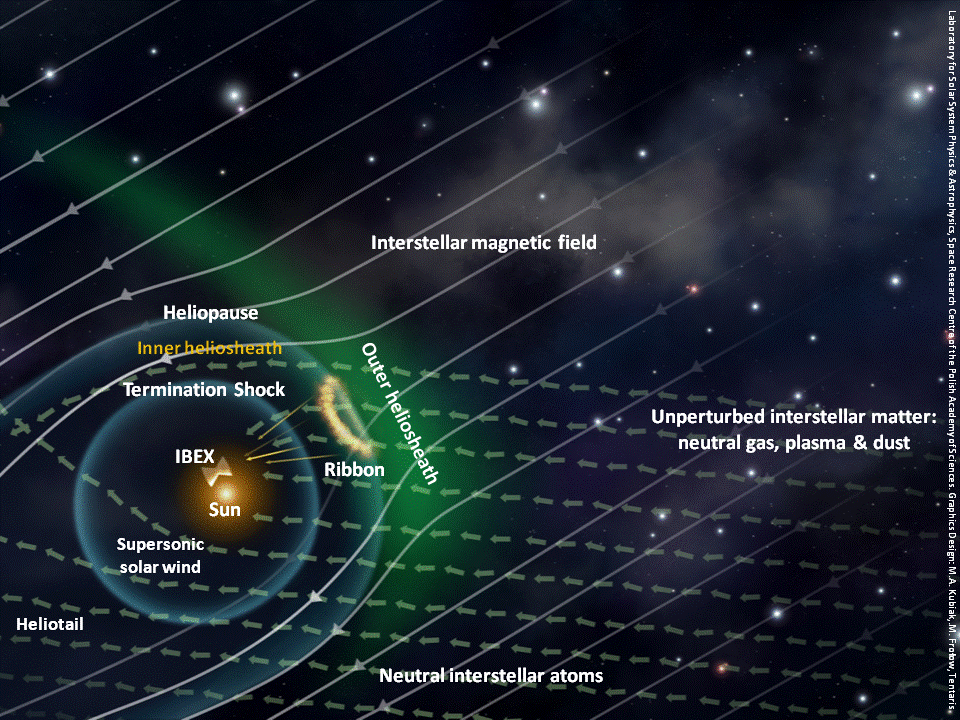
Rzut oka artysty na heliosferę i jej najbliższe otoczenie w Galaktyce. Słońce zanurzone jest w Obłoku Lokalnym materii miedzygwiazdowej, złożonej ze zjonizowanych i neutralnych atomów oraz ziaren pyłu i przenikniętej polem magnetycznym. Obłok Lokalny jest jednym z szeregu podobnych obłoków międzygwiazdowych zanurzonych w Lokalnym Bąblu bardzo gorącej (ok. miliona stopni) i rozrzedzonej, całkowicie zjonizowanej materii, będącej pozostałością po serii wybuchów gwiazd supernowych, które wystąpiły kilka milionów lat temu. Lokalny Bąbel rozciąga się na około 200 parseków. Słońce porusza się przez Obłok Lokalny z prawej do lewej strony rysunku, emitując wiatr sloneczny, czyli strumień całkowicie zjonizowanej, gorącej materii. Wiatr słoneczny ekspanduje we wszystkie strony z szybkością wielokrotnie przewyższającą szybkość dźwięku, jednak ekspansja ta nie jest sferycznie symetryczna – wykazuje The Sun moves through the cloud from right to left, emitting the solar wind - an ever-evolving, omnidirectional, latitudinally structured, hypersonic outflow of solar plasma. Subjected to the ram pressure of the ambient interstellar matter, the solar wind slows down through a shock wave called the solar wind termination shock and eventually flows downstream, forming a contact discontinuity surface called the heliopause, which separates the solar and interstellar plasmas, and an elongated heliotail (lower-left corner of the figure). The heliopause, hardly penetrable for charged particles, is transparent for neutral atoms. Energetic neutral atoms form everywhere in the heliosphere due to the charge exchange reaction between the ions from local plasma and neutral interstellar atoms. Charge exchange operates both in the supersonic solar wind and in the inner heliosheath, i.e., in the region between the termination shock and the heliopause. Some of those atoms run away freely from the heliosphere and due to eventual collisions slightly modify the inflowing interstellar gas. Other run in the opposite direction and reach the IBEX detectors (schematically drawn close to the Sun). Neutral atoms from the interstellar matter (whose streamlines are marked by the short arrows) also freely enter the heliosphere and some of them are detected by IBEX. In front of the heliosphere forms a disturbed region called the outer heliosheath (the green haze in the figure). In this region, the flows of interstellar plasma and interstellar neutral gas decouple. As a result, due to charge exchange another population of neutral atoms (former outer heliosheath ions) is formed. Some of them also enter the heliosphere and are detected by IBEX as the so called secondary population of neutral interstellar gas. Together with all other populations of neutral atoms they are important diagnostic means for the physical state of the distant regions where they originate. IBEX has discovered the surprising Ribbon – an arc-like, almost circular region of enhanced neutral atom emission on the sky. It seems the Ribbon is formed somewhere close to the heliopause, likely in the outer heliosheath, where the IBEX look direction is perpendicular to the local direction of interstellar magnetic field lines (marked by the long arrows that are draped at the heliopause). The currently most probable hypothesis is that the Ribbon center points towards the direction of the interstellar magnetic field. The action of interstellar magnetic field distorts the heliosphere from axial symmetry and likely pushes the heliotail to the side. Depending on the magnetic field strength, direction, and the relative speed between the Sun and the interstellar gas, the outer heliosheath may or may not be terminated by a shock wave called the bow shock. Assuming the interstellar gas velocity as obtained from the recent IBEX measurement, there is no bow shock, but the character of the wave-like structures in front of the heliosphere is much more complex than previously thought. Graphics design: Marzena A. Kubiak, Maciej Frołow, Tentaris.